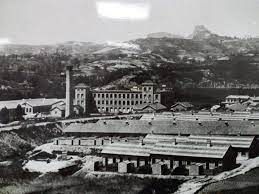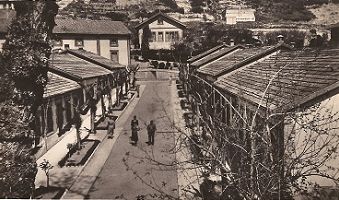Borgonya
In the foothills of the Pyrenees a little over half-way between the Mediterranean and the snow-capped, high peaks that mark the French border lies a small, almost insignificant village. It sits a little above the River Ter a couple of miles up-stream from the old town of Torello. The village is Borgonya, sometimes referred to as Colonia Borgonya, the Borgonya Colony. The reason is that it was an implantation, a foreign implantation, owing its existence to mountain-sourced water-power, that would drive the mill on one side of the railway south directly to Barcelona and which divides it from its grid of houses on the other. And at the centre of that grid are still three "carrers", three streets, lined with neat, terraced, brick-built workers' houses that have something of a local look but echoes of somewhere and something else, the clues to which lie in their names. The middle of them is Carrer Escocia, Scotland Street. The one to the left is Paisley. And to the right is Coats.


In 1894 the cotton-thread manufacturer, the Scots, Paisley-based manufacturer J. P. Coats, now the multinational Coats p.l.c, just as it would in a number of locations worldwide, had begun construction of said mill. And to get production started it sent out workers from the UK, almost all from Scotland, housing them in the three carrers with their wee, Hispano-Scots dwellings. And with the workers would, as elsewhere, be carried a passion for football, the almost immediate first implantation of the game not in Spain but not simply in Catalonia but outwith Andalusia.
1895 would see the formation of the sports club, the ‘Associacion de Torello’. The club exists to this day in the form of its 100-year-old golf course, golf also being an intrinsically Scots game, but fitba' as the Torello Football Association is already known to have been played even before then. Fragments of those days remain, in the form of a team consisting of predominantly Scots names,
Cochran (Team Captain) Paton, English (Inglis), Munro, Lyle, Gerard, Cooper, Al. Nichol, A. Tong and/or H. Tong, Rushton and King
which that same year would take part in two Association matches against a Barcelona Football Society eleven. The first in March, an away-game, was lost 6-3 perhaps 8-3, but with captain Cochran nevertheless scoring but the second, at home in April in Torello, perhaps even Borgonya, was won, 5-3 , Cochran scoring a first-half hat-trick. And it is this same Cochran, George Cochran, also recorded as Cochrane and Cockram, who had already and would be a key figure in football's introduction in Barcelona and in Bilboa in the Basque Country. Born in Bathgate of Angus-parents he was raised in Paisley, where he worked as a Clerk, and both were perhaps the key. At some point after early 1891 so in his very early twenties he arrived in Barcelona. Chances are that he came as part of a Coats advance party charged with identifying a mill site. Once in the Catalan capital he with London -born James Reeves were instrumental in the foundation in late 1892 of the Barcelona Football Club, where they were joined by a second probable Scot, William MacAndrews. All three feature in the earliest known photo of a football team, in fact two, in Spain. Taken in March 1893 it shows the Barcelona membership divided into two groups, the reds and the blues, perhaps roughly England and Scotland, captained respectively by Reeves and Cochran.
It is then said that the following year, 1894, Reeves and Cochran plus MacAndrews fell out and a club spilt resulted. But since the Cochran/MacAndrews faction is also said to have become the Torello Football Association it is far more likely that with the start of the Borgonya Mill that year the Scots in the club simply moved up-country, playing the recorded friendlies but otherwise leaving Barcelona to its own devices, not least the arrival of Hans Gamper in 1899 and the subsequent emergence of F.C. Barcelona as part of organised football in the city with its pivotal, second-wave Scots input.
Place Locator:
Other Sources:
Back to the Spanish Trail or the SFHGHome page